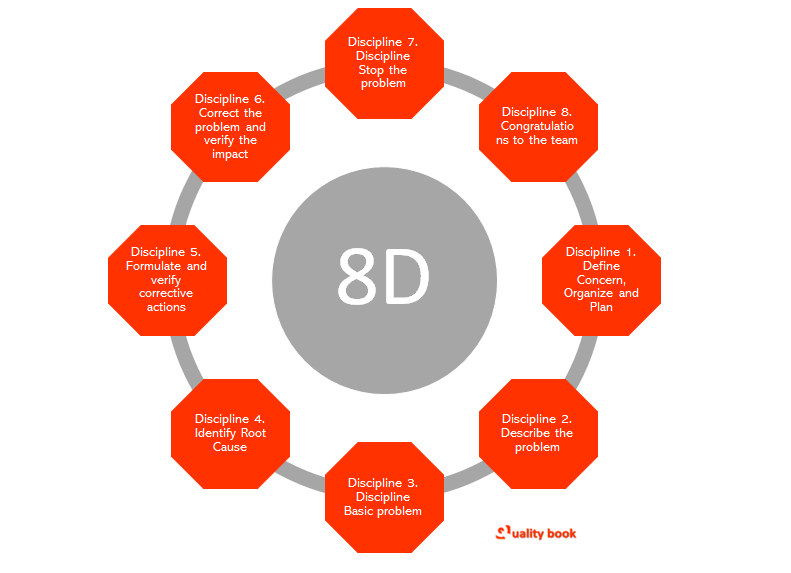The Eight Disciplines for Problem Solving (8D’s) refers to the process designed to find the root cause of a problem in order to find the best solution. The main objective of this process is to create a short-term change and implement a long-term solution to prevent the radiating problems altogether.
When it is confirmed that the product is defective or the customers are not getting full satisfaction, then it becomes very necessary to improve the quality and internal process so that the confidence of the customers can be established. These Eight Disciplines (8Ds) are important steps to achieve the same accomplishment.

What are the Eight Disciplines (8D’s)?
Eight Disciplines (8D) is an approach, which is a detailed and participatory process established in all processes of production to solve problems that are hindering product quality and production.
The goal of this approach is to find the root cause of the problem, further develop the established work to provide the customers with the desired product and prioritize corrective work to ensure that the problem does not recur in the future. In fact, the core and accomplishment of this Eight Discipline (8D) process lies naturally in its discipline, attitude, and methodology.
Why Apply Eight Disciplines (8D’s) in Organization?
Based on my experience, I can say that this method is very popular in the field of automobiles. Today it has become very necessary for the organization making any part of automobile to know and work on 8D. Because every automobile business gives priority to the customer (Organization with ISO / TS 16949 approved system). And he wants to know the whole process of steps taken to solve the problem, due to which eight disciplines (8D) are important for him.
What are the benefits of eight discipline (8D)?
If this process is implement correctly, you can expect the following benefits from this process:
- With the implementation of this process, the ability to understand the problems properly and work on them will increase.
- The employee will be able to take mature steps in advance to prevent problems in the future by taking lessons based on past streets, work, practices, and experiences.
- By implementing this process, the people working in the organization will get the opportunity and skill to work unitedly.
- Attempts to solve the problem can be summed up in a list of methods of organization.
- Better skills to take corrective action.
- The way of solving problems and problems and the understanding of the people associated with it will improve.
- Practical understanding will increase to understand each and every problem in a better way.
So, friends, let us understand these eight disciplines in detail.
Discipline 1. Team Building This is the first step in the 8D process and the first part of the 8D report.
This in part defines the structure of the team. The team is made up of people with different knowledge and skills by choosing from different functional departments.
Discipline 2. Describe the problem
This step involves a detailed assessment of the problem presented by the customer. In this discipline of 8D report, all the information given by the customer is specially supported with complete information which is the main purpose and problem information.
Discipline 3. Discipline Basic problem
This discipline problem basically sets the limit. So that the manager can focus on the root problem and identify the affected process and product.
Discipline 4. Identify Root Cause
This Discipline D process step requires failure analysis and investigation to determine the root cause of the problem. Details of root cause analysis carried out in the relevant part in the 8D report. With details description of the actual failure mechanism should be given, to show that the failure is fully understand.
Discipline 5. Formulate and verify corrective actions
This discipline allows us to focus on the root cause of the problem and list all possible corrective actions needed. In which when each task has to be complete and what is the main goal.
Discipline 6. Correct the problem and verify the impact
The sixth discipline involves actual implementation of the identified corrective actions. In this, when this work will be complete and for which corrective action will be taken, it will have to be writes. And it also has to be said that corrective action is effective in stopping the root cause of the process problem.
Discipline 7. Discipline Stop the problem
This is the problem presents in the discipline to end it by finding a solution as soon as possible. It may be that now the problem may not showing that serious or not, but in future this problem should also not raised its head as a big problem, that too has to be kept in mind.
Discipline 8. Congratulations to the team
The last step of the 8D process and the last part of the 8D report extend congratulations and best wishes to the management for the good work done by the 8D team.